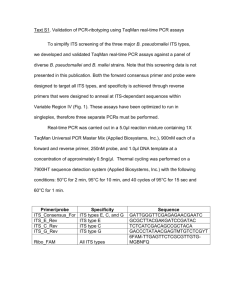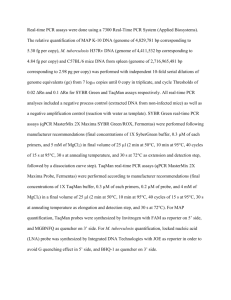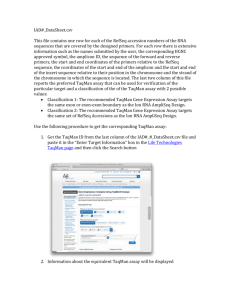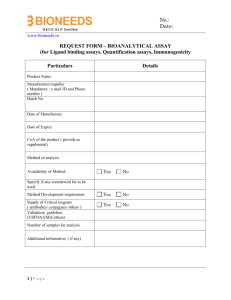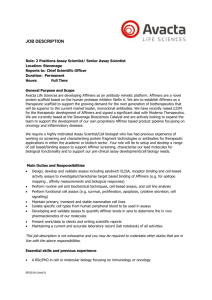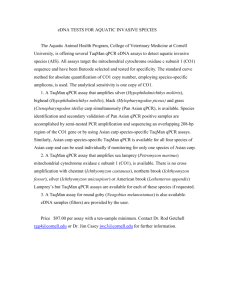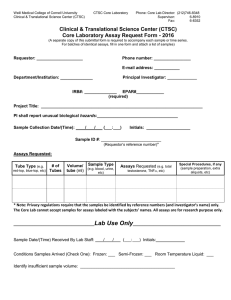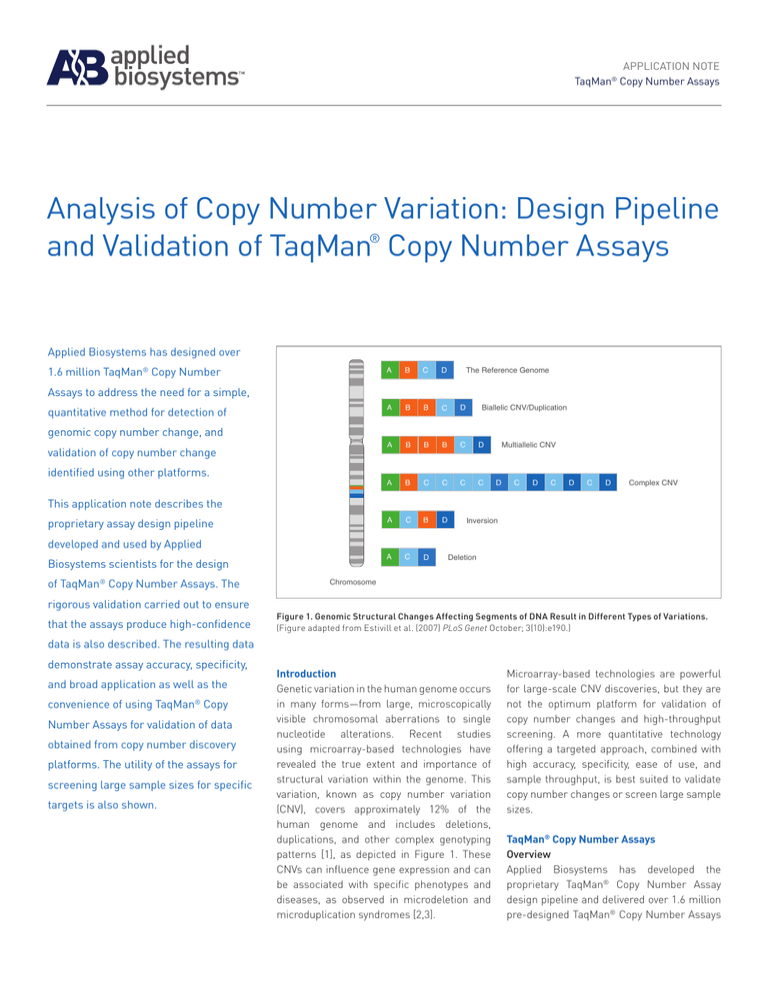
APPLICATION NOTE
TaqMan® Copy Number Assays
Analysis of Copy Number Variation: Design Pipeline
and Validation of TaqMan® Copy Number Assays
Applied Biosystems has designed over
1.6 million TaqMan® Copy Number
A
B
C
D
A
B
B
C
D
A
B
B
B
C
D
A
B
C
C
C
C
A
C
B
D
A
C
D
The Reference Genome
Assays to address the need for a simple,
quantitative method for detection of
Biallelic CNV/Duplication
genomic copy number change, and
validation of copy number change
identified using other platforms.
Multiallelic CNV
D
C
D
C
D
C
D
Complex CNV
This application note describes the
proprietary assay design pipeline
Inversion
developed and used by Applied
Biosystems scientists for the design
of TaqMan® Copy Number Assays. The
Deletion
Chromosome
rigorous validation carried out to ensure
that the assays produce high-confidence
Figure 1. Genomic Structural Changes Affecting Segments of DNA Result in Different Types of Variations.
(Figure adapted from Estivill et al. (2007) PLoS Genet October; 3(10):e190.)
data is also described. The resulting data
demonstrate assay accuracy, specificity,
and broad application as well as the
convenience of using TaqMan® Copy
Number Assays for validation of data
obtained from copy number discovery
platforms. The utility of the assays for
screening large sample sizes for specific
targets is also shown.
Introduction
Genetic variation in the human genome occurs
in many forms—from large, microscopically
visible chromosomal aberrations to single
nucleotide alterations. Recent studies
using microarray-based technologies have
revealed the true extent and importance of
structural variation within the genome. This
variation, known as copy number variation
(CNV), covers approximately 12% of the
human genome and includes deletions,
duplications, and other complex genotyping
patterns [1], as depicted in Figure 1. These
CNVs can influence gene expression and can
be associated with specific phenotypes and
diseases, as observed in microdeletion and
microduplication syndromes [2,3].
Microarray-based technologies are powerful
for large-scale CNV discoveries, but they are
not the optimum platform for validation of
copy number changes and high-throughput
screening. A more quantitative technology
offering a targeted approach, combined with
high accuracy, specificity, ease of use, and
sample throughput, is best suited to validate
copy number changes or screen large sample
sizes.
TaqMan® Copy Number Assays
Overview
Applied Biosystems has developed the
proprietary TaqMan® Copy Number Assay
design pipeline and delivered over 1.6 million
pre-designed TaqMan® Copy Number Assays
Step 1
Sequence Preparation
• Mask SNPs, repeats, etc.
• Identify target location
• Ensure specificity of target sequence
Step 2
Assay Design
• Apply optimal assay design parameters
• Generate probes and primers using
proprietary assay design algorithm
Step 3
In Silico Quality Control
Algorithm performs in silico QC to:
• Ensure each assay is specific for a
unique target sequence
• Ensure compatibility with reference
assays used in duplex reactions
Figure 2. TaqMan® Copy Number Assay Design Pipeline.
to meet the demand for more quantitative,
accurate, and specific copy number detection.
These assays target genes (coding and
noncoding regions) and intergenic regions,
and are useful for screening large numbers
of samples and validating data obtained from
microarrays and other discovery platforms.
TaqMan
Copy Number Assays enable
quantitative detection of DNA copy number
using gold standard real-time PCR TaqMan®
probe technology, and incorporate a simple
workflow. The assays are run in duplex with
VIC® dye-labeled TaqMan® Copy Number
Reference Assays. These reference genes are
known to be present in two copies in a diploid
genome, regardless of the copy number of the
target of interest, and are used to normalize
sample input and minimize the variation
between the targets of the test and reference
assays.
®
Assay Coverage
Pre-designed TaqMan® Copy Number Assays
offer genome-wide coverage encompassing
over 95% of RefSeq genes and 85% of copy
number variants in the Database of Genomic
Variants (DGV; version hg18.v6). There are on
average 40 assays per gene and 80 assays per
CNV locus, with a median assay spacing of 0.5
to 1 kilobase.
In the event that a pre-designed assay is not
available for a region of interest, Custom
TaqMan® Copy Number Assays can be
designed. The GeneAssist™ Copy Number
Assay Workflow Builder Tool incorporates
Applied Biosystems assay design algorithms
and facilitates easy online submission of
selected genomic regions for custom assay
designs.
TaqMan® Copy Number Assay
Design Pipeline
TaqMan® Copy Number Assay probes
and primers are designed to target DNA
sequences of the genes or genomic regions
of interest using a sophisticated, proprietary
bioinformatics pipeline, which comprises
three main steps (Figure 2).
Step 1—Sequence Preparation
The public reference genome Build 36
assembly is used as the sequence source
for the target regions to which assay probes
and primers will be designed. The target
sequences include genes, known CNV
regions, and other regions of the genome. The
process involves:
• Masking known SNPs
• Masking sequence repeats
in the genome
• Identifying the target location
• Ensuring specificity of the
target sequences
Carrying out these procedures ensures that no
probe or primer is designed over ambiguous
or known variant nucleotides, and that only
unique high-quality target sequences are put
through the pipeline.
Step 2—Assay Design
Applied
Biosystems
scientists
have
empirically determined parameters to select
oligonucleotide sequences that are most
likely to result in successful amplification.
Proprietary software algorithms generate
probe and primer designs for the target
sequences. To ensure high amplification
efficiency, these algorithms include optimal
design requirements for parameters such as
sequence composition, Tm, amplicon length,
salt and oligonucleotide concentrations,
thermodynamics, and minimal secondary
structure.
Step 3—In Silico QC
This step performs two functions. First, it
ensures that each assay is specific to the
target sequence for which it was designed
(i.e., the assay will not detect sequences
from other regions). Secondly, it ensures that
each assay is compatible with the TaqMan®
Copy Number Reference Assays used in
duplex with TaqMan® Copy Number Assays.
Assays designed for each target sequence are
processed through a quality scoring system,
and only the ones that meet the specified
criteria are added to the pre-designed
TaqMan® Copy Number Assay collection.
Custom TaqMan® Copy Number Assays
For Custom TaqMan® Copy Number Assays,
customer-submitted target sequences are
run through the same assay design algorithm
used to generate the pre-designed assay
collection. In silico QC, however, does not
include a genomic sequence check (i.e.
assays are not checked for whether they
will detect sequences from other regions).
Custom assays can be checked, however, for
compatibility with the TaqMan® Copy Number
Reference Assays.
Validation of TaqMan® Copy Number Assay
Design Pipeline
To validate the assay design pipeline, over
1,000 assays were randomly selected.
TaqMan® Copy Number Assays were tested
on a panel of genomic DNA samples,
comprising 45 African-American and 45
Caucasian samples, purchased from the
Coriell Institute of Medical Research. A subset
of these assays was also tested on aneuploidy
samples, HapMap samples, and on samples
with known deletions or duplications [4].
All reactions with TaqMan® Copy Number
Assays were performed in duplex using the
FAM™ dye label-based assay for the target
of interest and the VIC® dye label-based
TaqMan® Copy Number Reference Assay for
RNase P. Amplification reactions (10 µL),
which were performed in quadruplicate,
consisted of:
• 10 ng gDNA
• 1X TaqMan® Copy Number Assay
• 1X TaqMan® Copy Number Reference
Assay, RNase P
• 1X TaqMan® Genotyping Master Mix
4
5
4
Copy Number
Copy Number
3
2
1
0
3
2
1
0
Sample
Panel A. OTC Copy Number Profile.
Sample
Panel B. AMPD1 Copy Number Profile.
5
5
4
3
Copy Number
Copy Number
4
2
1
3
2
1
0
0
Sample
Panel C. C4A Copy Number Profile.
Sample
Panel D. C4B Copy Number Profile.
Figure 3. Copy Number Profiles of Selected OMIM Genes. TaqMan® Copy Number Assays were used to analyze a panel of genomic DNA samples from AfricanAmerican and Caucasian populations (45 samples each). Each sample bar represents the mean calculated copy number for four sample replicates with an error bar
showing the standard deviation. Panel A shows the copy number profile for the OTC gene, located on X chromosome. All male samples contain one copy, while female
samples contain two copies of the OTC gene. Panel B shows estimation of AMPD1 copy number. Deletions were detected in some African-American samples. Panels
C and D show distinct copy number profiles for C4A and C4B, respectively, which encode isoforms of the C4 gene family. Error bars show the standard deviation of the
copy number for the four replicates.
PCR was performed with an Applied
Biosystems 7900HT Fast Real-Time PCR
System using the default, universal cycling
conditions. Cycle threshold (Ct) values were
calculated by the SDS v2.3 software, then
relative quantitation analysis was done to
estimate copy number for each sample by
the ∆∆Ct method. Assay performance was
evaluated by metrics including call rate,
accuracy, and reproducibility. This information
was used to set and assess optimal design
scoring thresholds for the assay design
pipeline. Examples of the tests carried out
to validate the TaqMan® Copy Number Assay
design pipeline are described here.
Copy Number Determination
of OMIM Genes
The assays selected to validate TaqMan® Copy
Number Assays included some targeted at
OMIM (Online Mendelian Inheritance in Man)
genes [5]. Four of the copy number profiles
for these OMIM genes are shown in Figure 3
as examples of the data obtained during the
larger validation study. They are: ornithine
carbamoyltransferase
(OTC),
adenosine
monophosphate deaminase 1 (AMPD1),
and isoforms of the complement C4 gene
family, C4A and C4B. A distinct copy number
profile was obtained for each gene. For the
OTC gene, located on the X chromosome,
one or two copies were detected in the DNA
panel, consistent with the sample gender
information (Figure 3, Panel A).
For the AMPD1 gene, no variation in copy
number was observed for DNA from
individuals in the Caucasian population, but
deletions were observed in five individuals
from the African-American population (Figure
3, Panel B).
The C4A and C4B genes differ in only five
nucleotides within a small 18 bp region of
their sequences, making differential detection
of copy number very challenging. The proteins
encoded by these genes are functionally
different, and low copy numbers of the C4A
gene have been associated with susceptibility
to lupus, an autoimmune disorder [6]. As
such, it is important that any assay designed
to detect either of these genes is able to
distinguish between them. TaqMan® Copy
Number Assays targeted at these genes
were able to discriminate between the two
isoforms, displaying distinct copy number
profiles for C4A and C4B (Figure 3, Panels C
and D).
These data demonstrate the excellent
performance of TaqMan® Copy Number
Assays, including their ability to distinguish
between C4A and C4B genes, which comprise
highly homologous sequences.
Accuracy of TaqMan® Copy
Number Assays
The ability of TaqMan® Copy Number Assays
to accurately estimate copy number was
determined using genomic DNA samples of
known aneuploidy purchased from the Coriell
Institute of Medical Research. Chromosomal
aberrations had been previously identified by
cytogenetic methods.
Multiple TaqMan® Copy Number Assays were
designed across a given chromosome, and
used for copy number determination in these
aneuploidy samples. Normal and aneuploidy
samples were tested for each assay. The
assays were able to accurately determine the
Copy Number
y
21
Copy Number
os
om
XY
XX
XX
XX
XX
XY
XY
XX
XX
XY
XXX
XXXX XXXXX
XY
XY
Normal
XX
XX
XY
Normal
M
on
Trisomy 21
Panel C. Chromosome 22 (PIWIL3).
XYYYY
om
Tr
is
Normal
XYYYY
XY
XYYYY
XX
XXYY
XX
XYY
XY
XYY
XY
y
22
Copy Number
Panel B. X Chromosome (YIPF6).
Copy Number
Panel A. Chromosome 21 (C210RF91).
XY
XY
XX
XX
XY
Normal
Panel D. Y Chromosome (EIF1AY).
Figure 4. TaqMan® Copy Number Assays Accurately Identify Aneuploidy. TaqMan® Copy Number Assays were designed to target different sequences across each of
the chromosomes analyzed. (A) Detection of monosomy and trisomy of chromosome 21, with two copies of target detected in normal samples. (B) Duplication of the
X chromosome is detected in aneuploidy samples, while one or two copies of target are detected in normal samples taken from males and females, respectively. For
chromosome 22, trisomy is detected in the sample with aneuploidy (C) and two copies of target in samples from normal individuals. (D) One copy of the Y chromosome
is detected in males, while no Y chromosome target is detected in females. Error bars show the standard deviation of the copy number for the four replicates.
copy number of the targeted regions in a given
chromosome for each of the samples tested.
Examples of one assay for each chromosome
are shown (Figure 4). For chromosome 21, one
copy was detected in a monosomy 21 sample,
while three copies were detected in samples
with trisomy 21 (Figure 4, Panel A). For the X
chromosome, normal samples showed one or
two copies of target depending on gender of
samples. Three to five copies of targets were
detected in aneuploidy samples consistent
with the known chromosomal numbers
of the samples (Figure 4, Panel B). Three
copies of chromosome 22 were detected in
a sample with trisomy 22, while two copies
were detected in normal samples (Figure 4,
Panel C). For the Y chromosome, aneuploidy
samples with two or four Y chromosomes
were detected as having two or four copies,
respectively. Additionally, one copy of the Y
chromosome target was detected in males,
and zero copies were detected in females
(Figure 4, Panel D).
The accuracy of TaqMan® Copy Number
Assays was further established in a study
using samples of known copy number,
performed in collaboration with Dr. E. Eichler
at the Department of Genome Sciences,
University of Washington. Dr. Eichler and
colleagues are studying how structural
variation contributes to genomic disorders
(e.g., mental retardation, epilepsy, autism, and
other congenital anomalies).
To understand the genomic mechanisms for
these disorders, the researchers wanted to
map the deletion breakpoints in the DNA of
patients with deletions using microarrays. It
was necessary to identify individuals with the
chromosomal aberration before this could
be done. However, these aberrations have an
extremely low frequency of approximately 0.2–
0.4%, and it would not have been financially
feasible or time-efficient to screen thousands
of samples using microarrays.
Before the assays could be used to screen
the population, however, their accuracy had
to be demonstrated. This application note
presents the validation data that resulted
from a study using samples of known copy
number. Positive control samples, depicted
as orange bars in Figure 5, had previously
been identified by other technologies. Four
normal samples with two copies of each of
the regions analyzed were also included as
controls (Figure 5, blue bar). Finally, two copy
number assays targeting the X chromosome
were used as additional controls. In large
sample screens, verifying the gender of a
sample can help detect possible sample mixups. As well, the results of the X chromosome
assays demonstrate that the duplication
and deletion events detected are specific to
targeted chromosomal regions.
To overcome this constraint, five TaqMan®
Copy Number Assays were designed to
targets across each chromosomal region
of interest. Four targets of interest were
selected for the study; target regions ranged
in size from 500 to 1,200 kb. The regions of
interest and their sizes are shown in Table 1.
All five TaqMan® Copy Number Assays
designed to target each chromosomal region
correctly and consistently identified the copy
number of the region of interest (Figure 5).
All deletions and duplications determined
by the TaqMan® Copy Number Assays were
consistent with the findings of the previous
Table 1. Chromosomal Locations of the Target Sequences Used to Validate TaqMan® Copy Number Assays.
No. of Positive
Samples
Chromosomal Coordinates
Size of Region
(kilobases)
Assay Location
del 17q21.31
4
chr17:41100000-41500000
500
Chr17
dup/del 1q21.1
1
chr1:145100000-145800000
700
Chr1
del 15q24
3
chr15:72300000-73500000
1,200
Chr15_72M
del 15q13.3
1
chr15:29000000-29500000
500
Chr15_29M
5.0
5.0
4.0
4.0
Copy Number
Copy Number
Aberration
3.0
2.0
2.0
1.0
1.0
0.0
0.0
Assay1
Assay2
Assay3
Assay4
Assay5
Xctrl 1
Assay1
Xctrl 2
Panel A. Chr17: Four Samples With Del 17q21.31.
Assay2
Assay3
Assay4
Assay5
Xctrl 1
Xctrl 2
Panel B. Chr1: One Sample With Del 1q21.1; One Sample With Dup 1q21.1.
5.0
5.0
4.0
4.0
Copy Number
Copy Number
3.0
3.0
2.0
3.0
2.0
1.0
1.0
0.0
0.0
Assay1
Assay2
Assay3
Assay4
Assay5
Panel C. Chr15_72M: Three Samples With Del 15q24.
Xctrl 1
Xctrl 2
Assay1
Assay2
Assay3
Assay4
Assay5
Xctrl 1
Xctrl 2
Panel D. Chr15_29M: One Sample With Del 15q13.3.
Figure 5. TaqMan® Copy Number Assays are Validated by Samples With Known Copy Number. Five TaqMan® Copy Number Assays were designed across each
chromosomal region of interest. The assays correctly determined the copy number of all positive control samples tested (orange bars). Deletions were observed in all
positive samples using assays targeted at assay locations Chr17, Chr15_72M, and Chr15_29M, while assays that targeted Chr1 revealed a duplication in the positive
sample. Normal samples known to have two copies of each target region were used as controls (blue bars), as were assays targeting the X chromosome. Positive
control samples were previously identified [3]. Error bars show the standard deviation of the copy number for the four replicates.
report that used other technologies to
determine the copy numbers of these regions
[4]. Two copies were detected in all four
normal control samples in each chromosomal
region of interest. The copy numbers from
the X chromosome control assays were
consistent with the gender of each sample.
Convinced of the accuracy of the assays, Dr.
Eichler proceeded to screen over 1,000 patient
samples. Four new individuals with the
15q13.3 deletion were identified for further
breakpoint mapping analysis, while a further
two individuals with the 1q21.1 deletion were
also identified.
TaqMan® Copy Number Assays
Validate Data From Other Technologies
The ability of TaqMan® Copy Number
Assays to validate data obtained using other
technologies was demonstrated through
collaborations with Drs. W. Bi and S.W.
Cheung at Baylor College of Medicine. Baylor
developed BAC array comparative genomic
hybridization (aCGH) for prenatal screening for
genomic and genetic disorders. Fluorescent
in situ hybridization (FISH) technologies were
used to confirm any positive findings [7].
A gain of copy number was identified in one
BAC clone with (sample CMA001), RP11422P15 at 10q26, using BAC CGH arrays
(Figure 6, Panel A). However, this duplication
was not confirmed by FISH (Figure 6, Panel B).
Three TaqMan® Copy Number Assays (shown
in blue, red, and green) were designed to target
different sequences across this region of
RP11-422P15. All three assays were run on a
set of samples including CMA001 and various
controls. The controls included seven normal
samples that contain two copies in the target
region. Additionally, two samples containing
a duplication in the region and one sample
RP11-422P15
Red: RP11-422P15
Test: Control Sample Ratio
Panel A. BAC Array CGH.
Green: A control probe in Chr 10q
Panel B. FISH.
Chrm 10 location (nt)
1
5.0
0.5
2.0
Panel C. TaqMan¨ Copy Number Assay.
dup
dup
Array Probe Locations
dup
normal 7
normal 6
normal 5
normal 4
normal 3
normal 2
normal 1
del 1
dup 2
dup 1
CMA001
0.0
Ð1
1.0
0
3.0
Ð0.5
T-test/Control Ratio
Copy Number
4.0
TaqMan¨ Assay Locations
Panel D. Oligo Array CGH.
Figure 6. TaqMan® Copy Number Assays Clarify Ambiguous Data From Other Platforms. (A) Identification of duplication in chromosme 10 region 10q26 by BAC aCGH,
circled in the green ratio plot (right). (B) Subsequent FISH analysis, which did not resolve the duplication. (C) Results of three TaqMan® Copy Number Assays targeting
different sequences within 10q26. In the copy number bar graph, the three assays are distinguished by color. The CMA001 sample is shown on the left, followed by two
control samples containing the duplication, one control sample containing a deletion, and seven normal samples having no CNV in this region. Error bars show the
standard deviation of the copy number for the four replicates. (D) The duplication in CMA001 was further confirmed using oligonucleotide array CGH; the location of the
TaqMan® Copy Number Assays are indicated by arrows.
containing a deletion were included. All three
TaqMan® Copy Number Assays identified a
duplication in the RP11-442P15 region of the
CMA001 sample. All copy number calls were
consistent across all three assays for each
sample (Figure 6, Panel C). The duplication
in CMA001 was later confirmed by highresolution oligonucleotide array CGH (Figure
6, Panel D).
For another sample, CMA003, BAC aCGH
revealed loss of copy number on chromosome
15, indicated by deletions in BACs RP11701H24 and RP11-125E1 (data not shown).
However, these deletions were not confirmed
by FISH. To resolve these ambiguous results,
three TaqMan® Copy Number Assays were
designed to target regions in both BACs. For
each BAC clone region, sample CMA003 was
analyzed along with three samples containing
a confirmed deletion in the target region
and six normal samples with two copies of the
targets. No deletion was detected in RP11125E1 (Figure 7, Panel A), but analysis of the
downstream adjacent BAC RP11-701H24
indicated that a partial deletion was present
and identified the breakpoint within these two
clones (Figure 7, Panel B). These results were
further confirmed by an oligonucleotide tiling
array; no deletion was detected in RP11-125E1
(Figure 7, Panel C), but a partial deletion was
detected in RP11-701H24 (Figure 7, Panel D).
These results demonstrate that while the
microarray technologies and FISH may
produce conflicting results from different
technologies, TaqMan® Copy Number
Assays are able to accurately detect these
aberrations, and can clarify ambiguities
resulting from using the other technologies.
Simple, Accurate Copy Number
Variation Detection
Applied
Biosystems
has
successfully
developed a proprietary TaqMan® Copy
Number Assay design pipeline that has been
rigorously assessed by testing over 1,000
assays for performance. Examples shown in
this Application Note include targets in OMIM
genes and in chromosomal regions associated
with microdeletion and microduplication
syndromes. The data shows that TaqMan®
Copy Number Assays can detect copy number
changes with high accuracy, as demonstrated
by their ability to correctly quantify targets of
known copy number in aneuploid samples and
other samples with characterized deletions
and duplications, and by concordance with
results from other platforms. The assays are
also highly specific for their target sequences,
as demonstrated by their ability to distinguish
between highly homologous C4 gene family
isoforms that differ by only five nucleotides.
4.0
4.0
3.0
3.0
Panel A. TaqMan® Copy Number Assay—RP11-125E1.
normal_6
normal_5
normal_4
normal_3
Panel B. TaqMan® Copy Number Assay—RP11-701H24.
Chrm 15 Location (nt)
0
–0.7
TaqMan® Assay Locations
Panel C. Oligo Array CGH—RP11-125E1.
del
del
normal
normal
normal
normal
–1
–0.5
0
T-test/Control Ratio
0.7
0.5
1
1.4
Chrm 15 Location (nt)
T-test/Control Ratio
normal_2
normal_1
del_3
normal_6
normal_5
normal_4
normal_3
normal_1
normal_2
0.0
del_3
0.0
del_2
1.0
del_1
1.0
del_2
2.0
del_1
2.0
test sample
Copy Number
5.0
test sample
Copy Number
5.0
TaqMan® Assay Locations
Panel D. Oligo Array CGH—RP11-701H24.
Figure 7. TaqMan® Copy Number Assays Validate Partial Deletions Detected by Oligonucleotide aCGH. Panels A and B show the results of TaqMan® Copy Number
Assays targeting three different sequences within the chromosome 15 BAC clones, RP11-125E1 and RP11-701H24, respectively. The three assays are distinguished by
color in the copy number bar graph. In each graph, the CMA003 sample is on the left, followed by three control samples containing deletions and seven normal samples
having no CNV in this region. A deletion and deletion breakpoint were detected by the copy number assays in RP11-701H24, but not in RP11-125E1. Error bars show the
standard deviation of the copy number for the four replicates. Panels C and D show confirmation of these results using oligonucleotide array CGH; the locations of the
TaqMan® Copy Number Assays are indicated by arrows.
TaqMan® Copy Number Assays incorporate
a flexible and simple workflow that can be
used for fast analysis of target regions in large
sample sets. They also provide a convenient
method for validation of CNV discovery
results. Furthermore, TaqMan® Copy Number
Assays offer a quick means of performing
cross-platform comparisons to clarify
ambiguous data, taking hours rather than
days to complete the experimental analysis.
3. Mefford H et al. (2008) Recurrent
rearrangements of chromosome 1q21.1
and variable pediatric phenotypes. N Engl
J Med 359:1685–1699.
4. Sharp AJ et al. (2006) Discovery of
previously unidentified genomic disorders
from the duplication architecture of the
human genome. Nat Genet 38:1038–1042.
5. www.ncbi.nlm.nih.gov/Omim/
References
1. Redon R et al. (2006) Global variation
in copy number in the human genome.
Nature 444:444–454.
2. Sharp AJ et al. (2008) A recurrent 15q13.3
microdeletion syndrome associated with
mental retardation and seizures. Nat
Genet 40:322–328.
6. Yang Y et al. (2007) Gene copy-number
variation and associated polymorphisms
of complement component C4 in human
systemic lupus erythematosus (SLE): low
copy number is a risk factor for and high
copy number is a protective factor against
SLE susceptibility in European Americans.
Am J Hum Genet 80:1037–1054.
7. Cheung SW et al. (2005) Development
and validation of a CGH microarray for
clinical cytogenetic diagnosis. Genet Med
7:422–432.
For Research Use Only. Not for use in diagnostic procedures.
Practice of the patented 5’ Nuclease Process requires a license from Applied Biosystems. The purchase of TaqMan® Copy Number Assays includes immunity from suit under patents
specified in the product insert to use only the amount purchased for the purchaser’s own internal research when used with the separate purchase of an Authorized 5’ Nuclease Core
Kit. No other patent rights are conveyed expressly, by implication, or by estoppel. For further information on purchasing licenses, contact the Director of Licensing, Applied Biosystems,
850 Lincoln Centre Drive, Foster City, California 94404, USA.
© 2009 Life Technologies Corporation. All Rights Reserved. Trademarks of Life Technologies Corporation and its affiliated companies: AB Logo™, Applied Biosystems®, FAM™,
GeneAssist™, VIC®. TaqMan is a registered trademark of Roche Molecular Systems,Inc.
Printed in the USA. 11/2009 Publication 135AP03-01 O-081720 1109
Headquarters
850 Lincoln Centre Drive | Foster City, CA 94404 USA
Phone 650.638.5800 | Toll Free 800.327.3002
www.appliedbiosystems.com
International Sales
For our office locations please call the division
headquarters or refer to our website at
www.appliedbiosystems.com/about/offices.cfm

